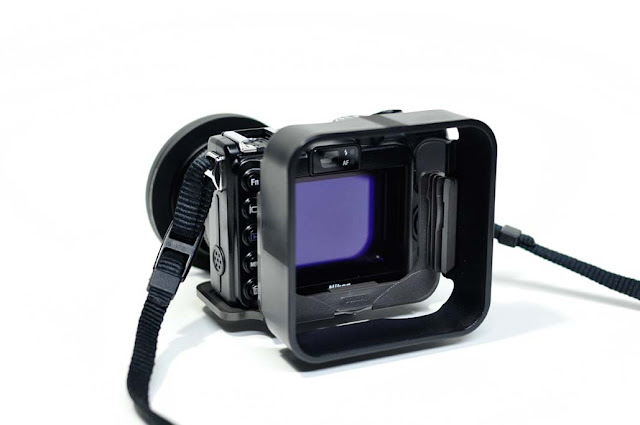Fortunately, I can outfit my Nikon P5100 with the same quality Nikon circular polarizer that I use on my other lenses. But, it comes at a price, because the viewfinder and flash are both partially blocked.
 |
| Nikon Coolpix P5100 outfitted for 67mm filters |
I’ve overcome one of these problems, and may just have the other one licked as well. I’ve installed a universal Cokin A-Series filter holder to the back of the camera, so I can use the hood as an LCD shade. It works pretty well. If I make a small, removable extension at the top of the hood, it will work even better.
I’d prefer not to use the LCD, but, it’s difficult, because it solves so many problems. First, it literally turns the camera into an SLR by letting you see exactly what the lens sees; no parallax error or partial coverage. Second, it gives me the shooting information I’m accustomed to seeing in my SLR viewfinder. My ideal “Bridge” camera (the equivalent of a 35mm rangefinder?) would have a viewfinder based on a miniature, internal LCD. This would give the best of both worlds. Or, a much simpler solution, a dedicated attachment complete with lens, to turn the existing LCD display into viable a viewfinder. Perhaps another project.
 |
| Cokin A-Series Universal Filter Holder and Hood as LCD Shade |
The first test revealed a harsh shadow created by the lens partially blocking the flash’s output. A business card slid between the body and the diffuser, just below the flash lens, solved the problem so well, that it’s worth further investigation. So, my next project is to fashion a mask to attach to the diffuser that will permit me to use the on-board flash with any kind of filter or secondary lens setup. Something I’ve actually been kicking around for some time now.
Now, on to some photos.
Beach day. Bright sunlight. Traveling light. No LCD shade. Incomplete sentences.
Long story short, I use the viewfinder because at the beach, even with the LCD shade, using the LCD is useless. So, I can’t see the effects of the polarizer. But, before I put it on the camera, I look through it and note which angle of rotation gives me the desired effect by observing the position of the tampo printing on the rim. Problem partially solved. I say partially, because with a DSLR, I could dial in an exact balance between the two settings, each 90° apart. With this method, I can only guess. But it’s the big change I’m going after today, so it’s not a real problem.
Each of these photos was taken with the polarizer on, but rotated 90° apart:
 |
| With Polarizer |
 |
| Without Polarizer |
It’s not unlike white balance. My brain “white balances” automatically when I move indoors, because I don’t perceive everything as having an amber cast. And, my brain processed the live image at the beach in such a way as it looked more like the bottom version, and not the top. But this is all very subjective, and part of the art of photography.
I didn’t take a picture with the polarizer off, as a 45° rotation would have provided an equivalent effect. Anything in between 0° and 45° would provide one effect, and between 45° and 90° another.
If I switch to 52mm filters, the scenario changes a bit. Only about 1/8 of the optical viewfinder is blocked, and that’s only at the widest zoom angle. So, it would be worthwhile investing in a 52mm polarizer for the P5100 so I could use the viewfinder (not that I couldn’t also use it with any of my other two, soon to be three 52mm-filter lenses). But, the flash would still be an issue.
So, if you’re planning a new camera purchase, and would like to use a polarizer, be sure it has the capability of adapting to standard filters. Keep in mind that the higher the quality of the polarizer, the more effective it will be; there will be less light loss, and less flaring.
Also, If you’re planning on using the LCD, avoid wearing polarized sunglasses. Because LCD screens have their own polarizing filters, the screen will go black if you rotate the camera 90° to shoot portrait. Another kudo for the optical viewfinder!


No comments:
Post a Comment